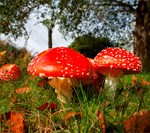| The Woodland Trust Scotland is asking people to keep an eye out for fly agaric (Amanita muscaria), the classic red and white spotted toadstool, during woodland walks and record any sightings online.Fly agaric is widespread throughout the UK and commonly found on light soils in mixed woodland and heaths among birch and pine.
Rory Syme from Woodland Trust Scotland said: “The best place to spot fly agaric is close to birch and pine trees. The wet summer we’ve had may mean that it will appear early this year. In previous years sightings have been recorded as early as the end of June.
“Keeping track of key events in nature helps us record the changing seasons. Natural phenomena such as bird migration, changes in leaves and the appearance of flowers and fungi are some of the best indicators for climate change.”
Fly agaric is toxic and was traditionally mixed with milk and left out in bowls to kill flies, which is where it gets its name.
Rory Syme added, “Fly agaric can be dangerous, so the best advice is to look but don’t touch.”
You can record sightings through the Nature’s Calendar Project atnaturescalendar.org.uk/
Five facts about fly agaric
• Fly agaric was traditionally used as an insecticide, the cap broken up and sprinkled into saucers of milk. It’s now known to contain ibotenic acid, which both attracts and kills flies
• The ‘spots’ are actually remnants of a white veil of tissue that encloses the young mushroom, and can sometimes be washed off by the rain
• It was commonly found on Christmas cards in Victorian and Edwardian times as a symbol of good luck and its colours may have been the inspiration for Santa Claus’s red and white suit.
• Fly agaric is mycorrhizal, forming a mutually beneficial relationship with its host tree. This association provides the tree with increased absorbtion of water and minerals, and the fungus with constant access to carbohydrates
• One of the effects of consuming fly agaric is a perceived distortion in the size of objects. It has been said that Lewis Carroll’s hookah-smoking caterpillar in Alice’s Adventures in Wonderland was inviting her to take a bite from a fly agaric. |


Leave a Reply